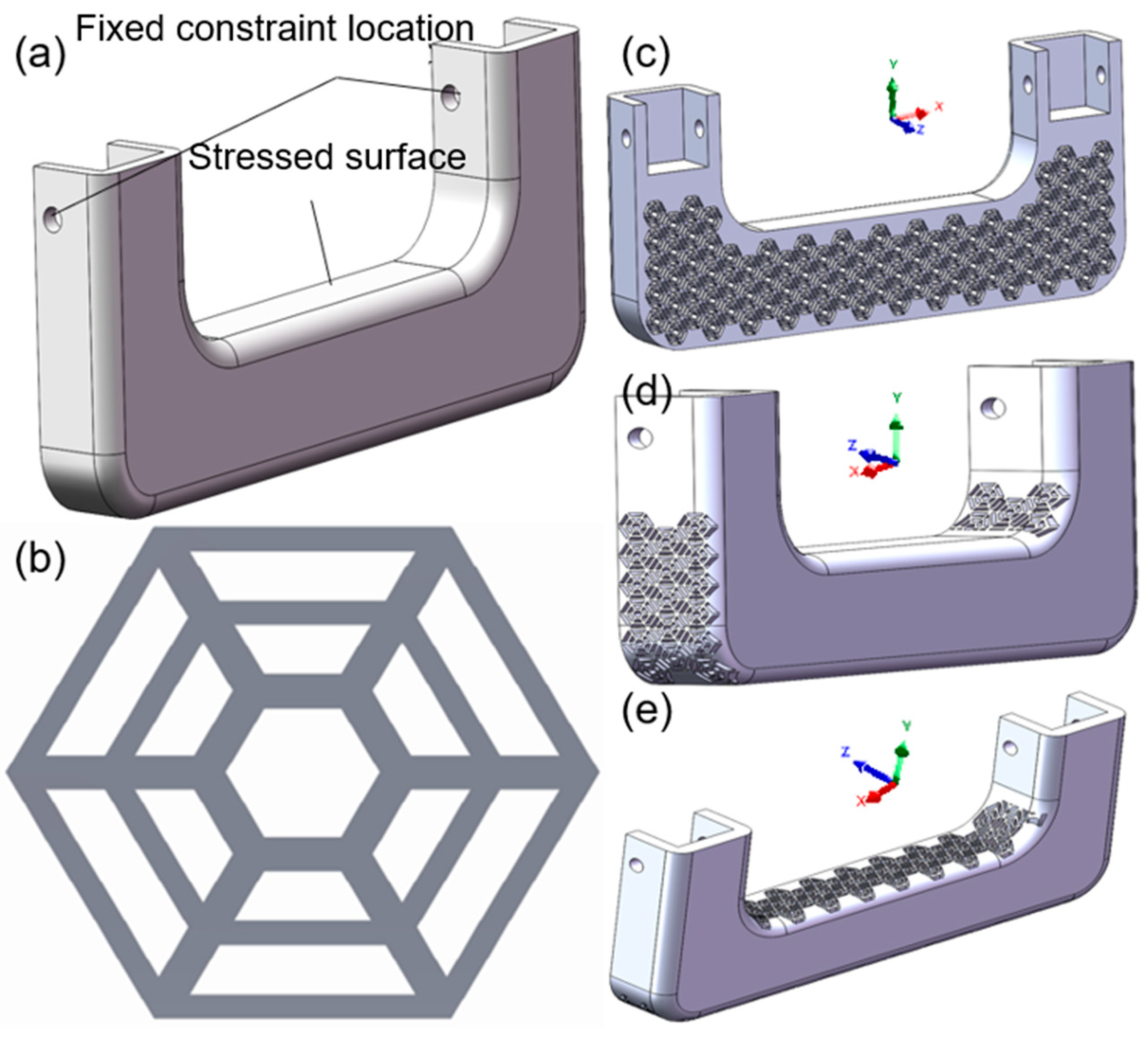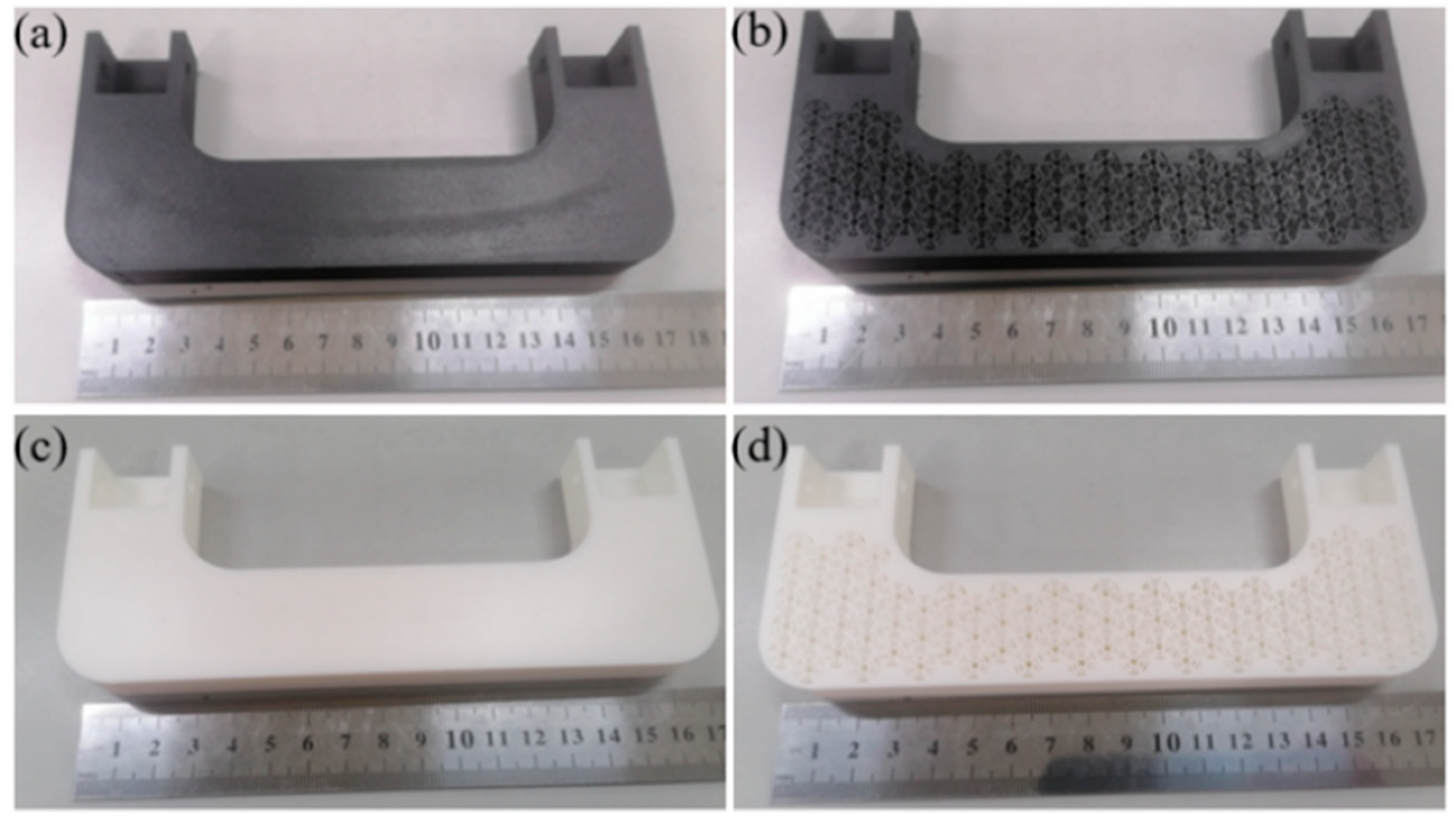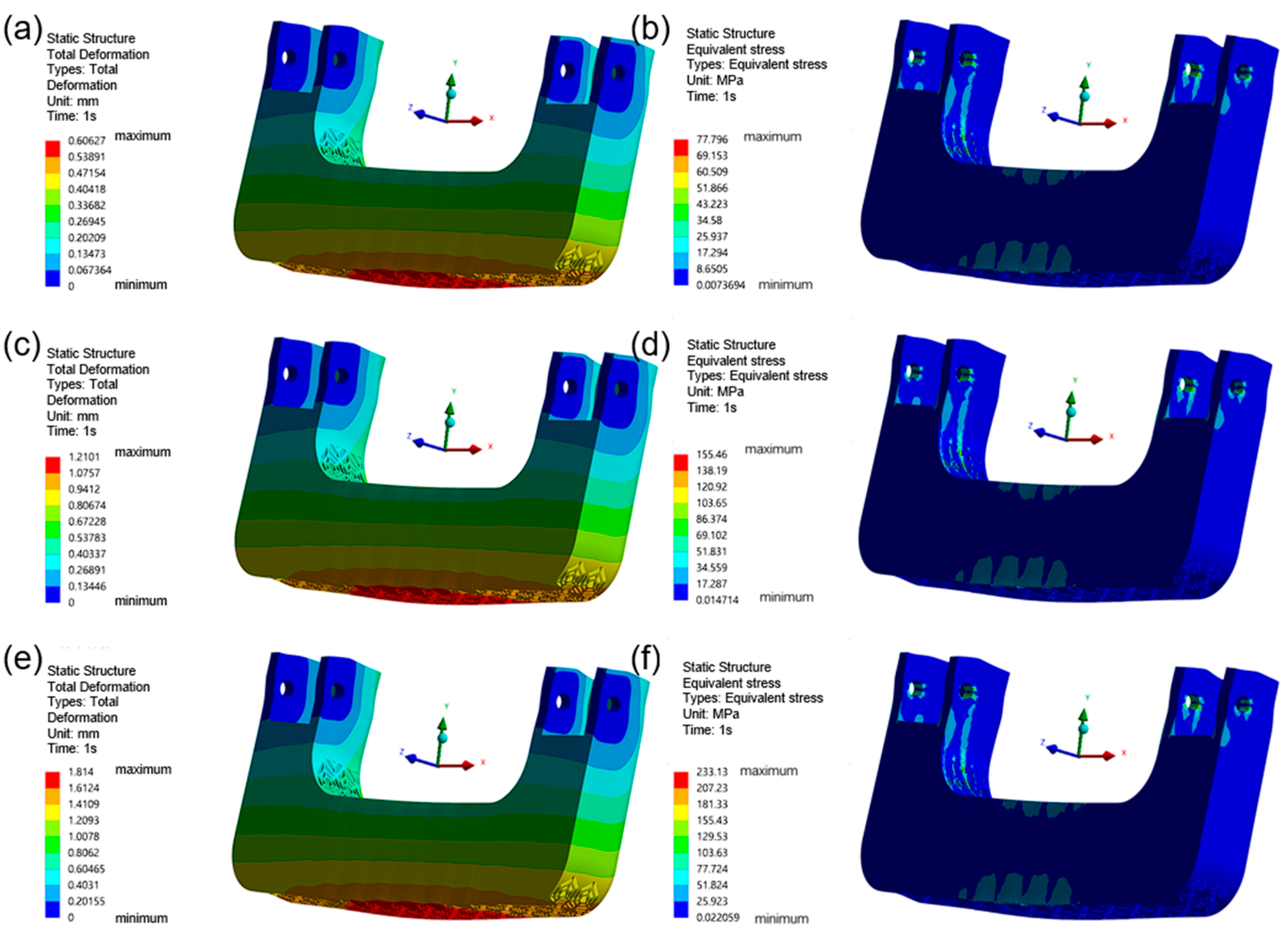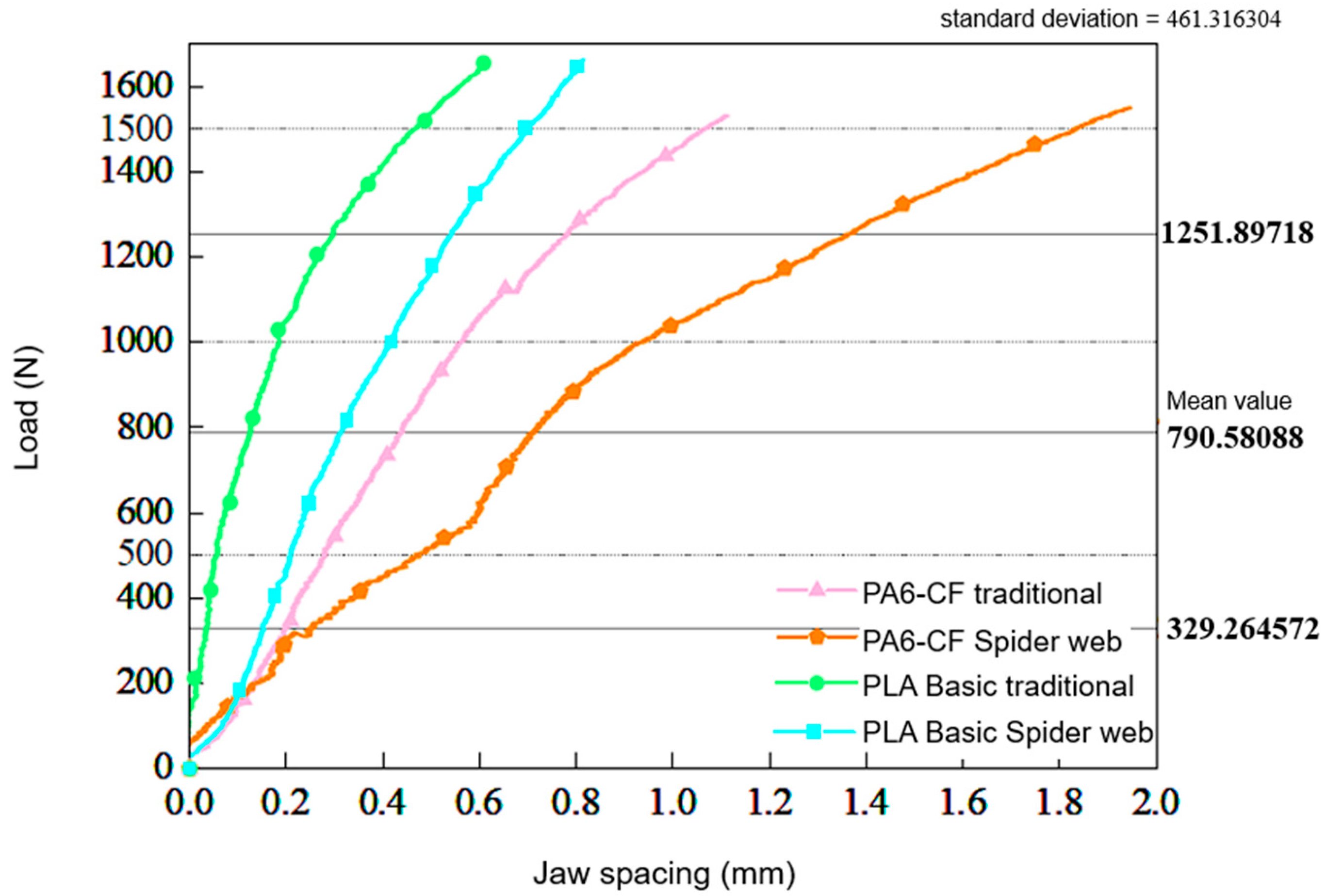1. Introduction
Automotive lightweighting engineering cars can improve performance of the car and reduce fuel consumption. At present, the mainstream direction of automotive lightweighting is to use computer structure optimization, new materials, and new manufacturing processes to reduce the weight of automotive components [
1]. This work attempts to combine additive manufacturing methods with mature industrial plastic materials, integrating spider web structures into automotive interiors to improve lightweighting levels. Meanwhile, many scholars both domestically and internationally are conducting research on automotive lightweighting.
Firstly, using static simulation and additive manufacturing as manufacturing methods is one of the current trends in lightweight engineering [
2]. Static simulation can reduce research costs, such as the simulation analysis of the characteristics of car wheels by Lv [
3]. Additive manufacturing technology can eliminate the need for traditional molds, handle a variety of complex structures, shorten product production cycles, reduce production costs [
4], and enhance material utilization [
5]. Li [
6] elaborated in his work that additive manufacturing has become the preferred technology for manufacturing complex structures, overcoming many limitations of traditional processing techniques and enabling the integration of biological structural features with intelligent materials to produce high-performance biomimetic structures. On the one hand, Yang [
7] studied the feasibility of using AlSi10MnMg in automotive components to achieve light weight; Li [
8] used bamboo fiber-reinforced polypropylene/polylactic acid composite raw materials to make automotive linings, replacing traditional plastic materials and improving lightweight qualities. On the other hand, scholars have discovered many lightweight structures by combining natural bionics, such as Qiao’s [
9] study on the performance of a new negative Poisson’s ratio honeycomb structure. Moreover, in the study of the performance of spider webs, Huang [
10] compared various spider web configurations through mathematical models and proposed the optimal mechanical performance of the Eight Trigrams-shaped spider web. Zhao [
11] analyzed the mechanism of spider web formation, combined with knowledge of mathematics, physics, and biology, analyzed the actual process of spider web formation, established mathematical models, and obtained the optimal web formation model for spiders. Guo [
12] successfully utilized the spider web structure to improve the turbine blade disc. Zhang [
13] utilized the excellent mechanical properties of the spider web structure to optimize the structure of personalized medical titanium mesh. It can be seen that the research and application of spider web biomimetic structures have gradually matured.
Research on automobile lightweighting began earlier internationally and has yielded numerous in-depth findings. For instance, Kartanas [
14] designed a new lightweight short-shift transmission aimed at reducing the weight of automobile mechanical structures; János Plocher [
15] believes that additive manufacturing technology will shine in the next generation of lightweight structural production. For instance, Kutnjak-Mravlinčić S [
16] utilized additive manufacturing technology to produce components for high heels to enhance product performance. Friedrich C [
17] utilized additive manufacturing technology to customize orthodontic appliances for patients; General Motors [
18] utilized additive manufacturing technology to produce high-strength and lightweight automotive components, effectively improving vehicle performance; Katrin Greta Hoffmann [
19] conducted in-depth research on the application of biomimetics in automotive lightweighting, revealing the feasibility of using biomimetic structures to achieve lightweight. Various biomimetic structures are being studied, and scholars are constantly exploring the potential of these structures. For example, Almonti [
20] used additive manufacturing technology to manufacture PETG honeycomb structures to study their mechanical properties. In addition to honeycomb biomimetic structures, the biomimetic structure of spider webs is also considered by many foreign scholars as an excellent choice for lightweight structures. He [
21] combined 3D printing technology with spider web structures to improve water collection efficiency and alleviate water scarcity in arid regions. The Yoyogi Gymnasium designed by Kenzo Tange [
22] features a suspended lock on the roof inspired by a spider web structure, which supports over 20,000 square meters of roof panels. Ko Frank K and Jovica Jovan [
23] conducted tensile, compressive, and torsional experiments on single spider silk using a micro-testing device. They measured the stress–strain curves under three different conditions and found that spider silk has unique high toughness and strength compared to artificial fibers. Sensenig Andrew T [
24] used high-speed video recorders to capture the deformation of the spider web at the moment of insect web collision, quantifying the energy dissipation of different types of spider webs. By combining data with experiments, the author concluded that radial silk energy dissipation is the main source of energy absorption throughout the entire process.
In order to further reduce the weight of the car, this work innovatively chose a spider web biomimetic structure for the lightweight design of the roof handrail, which combines performance and aesthetics. Firstly, based on the biomimetic structure of the Eight Trigrams spider web, combined with the U-shaped handrail of a specific NIO model, a model was created. Then, finite element software ANSYS 2024 R2 was used for simulation analysis to assist in design optimization. This work analyzed the influence of biomimetic spider web structures with different distribution directions on the performance of handrails. By comparing the performance of handrails made of PA6-CF and PLA Basic materials, analyzing their lightweight degree and mechanical properties, the optimal handrail material and structure were selected. In addition, for the first time, additive manufacturing technology was used to apply PA6-CF material to the roof handrail, achieving improvements in the handrail’s tensile strength and lightweight performance, as well as saving mold costs.
4. Test Results
In the simulation, it was measured that the z-axis direction spider web biomimetic structure handrail had a theoretical weight reduction of about 32.03% compared to the traditional car roof handrail. The processed sample handrail was weighed and verified, and the results are shown in
Table 8. The weighing equipment is an electronic balance.
According to
Table 8, the weight reduction rate between the new and old structures of PA6-CF material is about 26.19%, while the weight reduction rate between the new and old structures of PLA Basic material is about 28.16%. During the production process of FDM-based printers using PA6-CF material, due to its large thermal deformation, the printing accuracy is reduced, and the process requires extending the single-layer printing time and improving heat dissipation, which to some extent affects the weight of the finished product and thus affects the weight reduction rate. However, the simulation results of the spider web structure handrail of PA6-CF show sufficiently excellent performance, so the results are further confirmed through tensile testing below.
The load and deformation data graph of the test results is shown below.
According to
Figure 10, the handrails of both materials are in the elastic deformation range. Since both materials are brittle, if failure occurs, the curve should show a sudden drop in fluctuation. The curve in the figure indicates that all tested handrails can withstand a static load of 1500 N. At present, the standards for roof handrails used by various car brands are not uniform. Some brands only require a load-bearing capacity of 50–80 kg, while others require a load-bearing capacity greater than 150 kg. Therefore, the test results using 1500 N as the highest load standard in this work can demonstrate that the spider web structure handrail in this design meets the usage requirements.
Comparing the experimental results of different configurations of handrails under the same material, it can be seen that compared with traditional handrail structures, using spider web biomimetic structures increases elastic deformation and improves the energy dissipation capacity of the product [
31], which is in line with the laws in the simulation process. This feature is beneficial for improving the cushioning performance of the handrail during use and optimizing the user experience of the handrail.
Comparing handrails made of different materials, it was found that the degree of elastic deformation of PA6-CF material handrails is greater than that of PLA Basic material handrails. Both materials are brittle, and there is no sudden sharp drop in the curve from
Figure 10, so no brittle fracture has occurred, so they are still in the stage of elastic deformation. From
Table 2, it can be seen that the PA6-CF material selected in this work has a smaller Young’s modulus compared to the PLA base material, so PA6-CF usually has greater elastic deformation under the same load [
32,
33]. Therefore, the PA6-CF material handrail not only meets the usage requirements, but also provides better grip stability due to its high elastic deformation ability, can absorb some impact energy, reduce the impact on the arm during sudden bumps, and thus provide a better user experience. From the perspective of comprehensive safety and comfort, the PA6-CF material is more suitable.
In summary, the spider web biomimetic structure handrail of PA6-CF can ensure the strength of the handrail itself, further reduce the weight of automotive handrail components, optimize the handrail user experience, and meet the safety requirements of automotive use [
34].
5. Conclusions
This work combines additive manufacturing, simulation, automotive lightweight design, biomimetic structure, and other technologies, starting from the relatively inconspicuous roof handrail in automobiles, attempting to break down the huge engineering of automotive lightweighting into a series of small parts for lightweight design. The following summary is drawn from the simulation and experiment of the spider web biomimetic structure handrail:
1. This work integrates the spider web biomimetic structure into the roof handrail through additive manufacturing technology, achieving lightweight design of the roof handrail. Compared with traditional handrails, the theoretical weight of the spider web biomimetic structure handrail is reduced by 32.03%, and the actual weight is reduced by about 26.19%.
2. This work compares and analyzes three distribution combinations of spider web biomimetic structures on handrails, and clarifies that the spider web biomimetic handrail structure designed along the z-axis is the best solution.
3. This work pioneers the application of PA6-CF material in the manufacturing of roof handrails, improving their performance.
4. This work compares the handrail performance of PA6-CF and PLA Basic materials through finite element simulation analysis and experiments and determines the advantages of PA6-CF material in spider web biomimetic structure handrails. The handrail made of PA6-CF material not only meets the performance requirements but also ensures a good user experience.

















